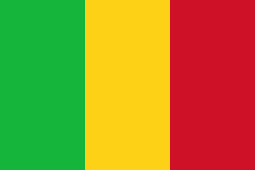Flag of Mali
 | |
| Use | National flag |
|---|---|
| Adopted | March 1, 1961 |
| Design | A vertical tricolor of green, gold and red. |
 | |
| Use | National flag |
| Adopted | April 4, 1959 |
| Design | A vertical tricolor of green, gold and red with a human stick figure (kanaga) in black with arms raised to the sky centered in the gold band. |
The flag of Mali (French: Drapeau du Mali) is a tricolour with three equal vertical stripes. From the hoist (the place where the flagpole meets the flag) the colours are green, gold, and red, the pan-African colors. The flag is almost identical to the flag of Guinea, with the exception that the colors are in reverse order.
Symbolism
The flags colors have different meanings. The green stands for fertility of the land, gold means purity and mineral wealth and lastly red symbolizes the blood shed for independence from the French.
History
The current flag was adopted on March 1, 1961. The original flag was adopted on April 4, 1959, when Mali joined the Mali Federation. This flag was the same, except the golden stripe had a human stick figure, a kanaga, in black, with arms raised to the sky. The figure was removed due to the opposition of Islamic fundamentalists[1] (see Aniconism in Islam, the belief against making pictures of the human figure).[2] (Mali is about 90% Muslim.)
The flag adopted in 1959 for the federation was an imitation of the Flag of Ghana, but following the style of the French Tricolore. It was charged with a black emblem known as a kanaga, a stylized human figure. The colors were intended to reflect a unity with other African nations. After the two countries split in 1960, the flag was kept for use in Mali until March 1, 1961, when the kanaga emblem was dropped.
References
- ^ http://www.britannica.com/EBchecked/topic/1355376/Mali-flag-of
- ^ Guide to the Flags of the World by Mauro Talocci, revised and updated by Whitney Smith (ISBN 0-688-01141-1), p. 124.
